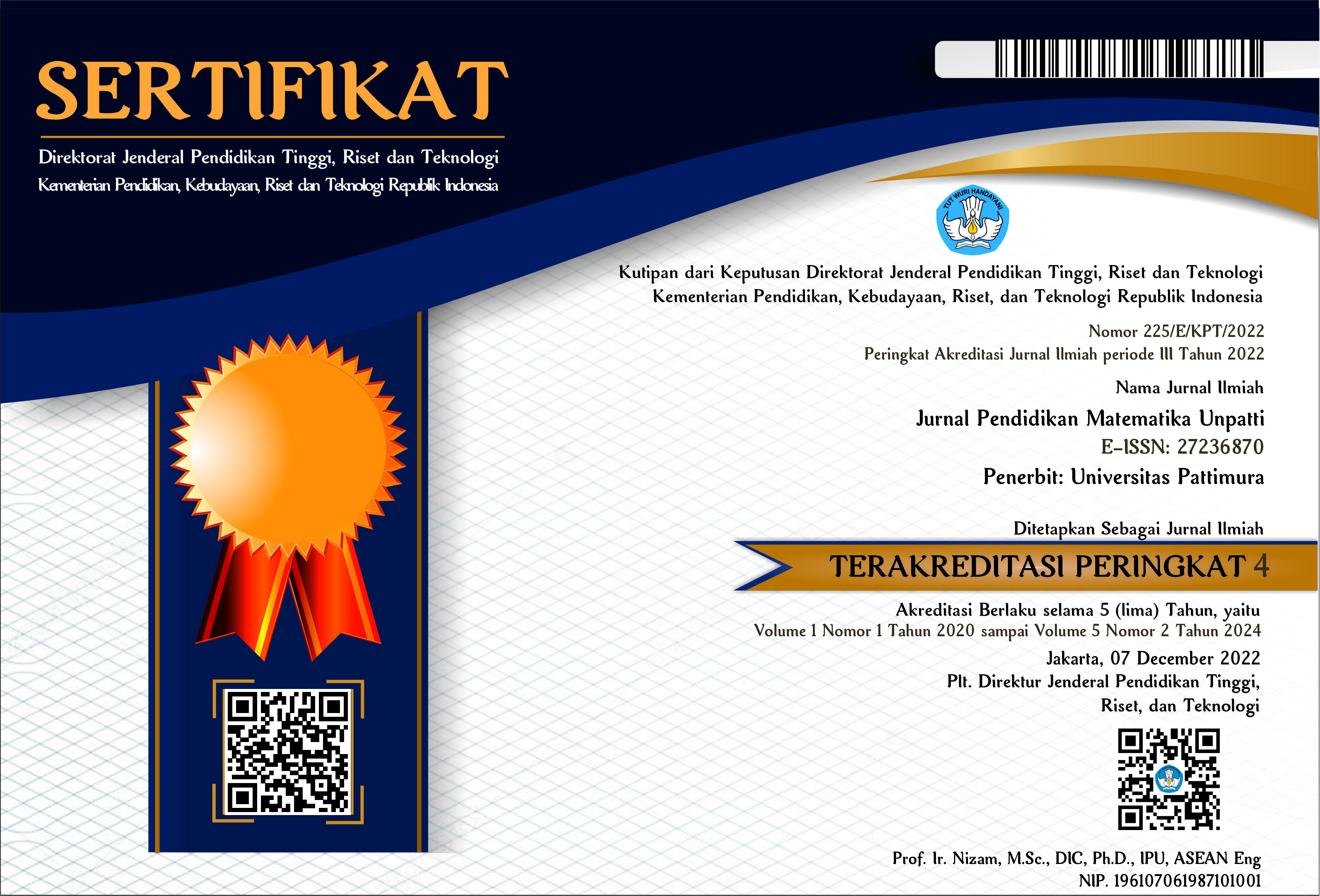PROSES BERPIKIR KREATIF GURU DALAM MENDESAIN TUGAS MATEMATIK
Abstract
Students have different backgrounds and abilities. Therefore, teachers must be good at choosing and giving math assignments to their students. The purpose of this study was to reveal the creative thinking process of teachers in designing math assignments. The participants in this study were elementary school teachers in Pangkep district, South Sulawesi based on their functional position (focusing on intermediate teachers). This study used a qualitative approach, with data collection methods using task-based interviews. From the results obtained, we found the subject's thinking process followed the sequence of stages of synthesizing ideas, constructing ideas, planning the application of ideas, and applying ideas.
Downloads
References
As’ari, A. R. 2009. Penugasan Belajar yang Tepat untuk Membantu Siswa Belajar Matematika Secara Bermakna. MIPA Dan Pembelajarannya, 33(1).
Breen, S., & O’Shea, A. (2021). Mathematical thinking and task design. Irish Mathematical Society Bulletin, 66, 39–49. https://doi.org/10.33232/bims.0066.39.49
Cobb, P., Yackel, E., & Wood, T. 1990. Classrooms as learning environments for teachers and Researchers. In RB Davis, CA Maher, & N. Noddings (Eds.), Affect and mathematical problem solving (pp. 117-148). New York: Springer-Verlag.
Jones, K., & Pepin, B. (2016). Research on mathematics teachers as partners in task design. Journal of Mathematics Teacher Education, 19(2–3), 105–121. https://doi.org/10.1007/s10857016-9345-z
Lee, K. H. (2017). Convergent and divergent thinking in task modification: A case of Korean prospective mathematics teachers’ exploration. ZDM - Mathematics Education, 49(7), 995–1008. https://doi.org/10.1007/s11858-017-0889-x
Liliasari, 2005. Membangun Keterampilan Berpikir Manusia Indonesia melalui Pendidikan Sains. Pidato Pengukuhan Guru Besar Tetap dalam Ilmu Pendidikan IPA. Bandung: Universitas Pendidikan Indonesia
NCTM. 2000. Six Principles for School Mathematics. In National Council of Teachers of Mathematics (pp. 1–6). Retrieved from http://www.nctm.org/uploadedFiles/Math_Standards/12752_exec_pssm.pdf
NCTM. 2015. Mathematical Understanding for Secondary Teaching: A Framework and Classroom-Based Situations. (M. K. Heid, P. S. Wilson, & G. W. Blume, Eds.). Charlotte, NC.: Information Age Publishing, INC.
Perkins, D. N., & Swartz, R. J. 1990. “The Nine Basics of Teaching Thinking.” Skyligh Publishing 2:53–69.
Silver, E. A., & Smith, M. S. 1997. “Implementing Reform in the Mathematics Classroom: Creating Mathematical Discourse Communities.” In Reform in Math and Science Education: Issues for Teachers. Columbus, OH: Eisenhower National Clearing House for Mathematics and Science Education.
Stein, M. K., & Lane, S. 1996. Instructional tasks and the development of student capacity to think and reason: An analysis of the relationship between teaching and learning in a reform mathematics project. Educational Research and Evaluation, 2(1), 50-80.
Sullivan, P., Clarke, P., Clarke, D. 2013. Teaching with Tasks for Effective Mathematics Learning. Springer New York Heidelberg Dordrecht London.
Suryadi, D. 2003. Pengembangan Kemampuan Berpikir Matematik Tingkat Tinggi. Kajian Mandiri I. UPI Bandung: Tidak di terbitkan.
Taufiq, dkk. (2023). Exploring What Teacher's Decision-Making in Designing Mathematical Assignments?: Case Studies in Beginner. IJORER: International Journal of Recent Educational Research, 4(4), 497-513.
Van Zoest, L. R., Enyart, A. 1998. Discourse of course: Engaging genuine mathematical conversations. Mathematics Teaching in the Middle School, 4(3), 150-158.
Widodo, S. 2013. Keterkaitan Antara Berpikir Kreatif Dan Produk Kreatif Guru Matematika Smp Dalam Membuat Soal Matematika Kontekstual. Cakrawala Pendidikan, 16(1), 97-109
Bibliography
Breen, S., & O'Shea, A. (2021). Mathematical Thinking and Task Design. Irish Mathematical Society Bulletin, 66, 39-49. doi:https://doi.org/10.33232/bims.0066.39.49
Henningsen, M., & Stein, M. K. (1997). Mathematical Task and Student Cognition: Classroom-based Factors taht Support and Inhibit High-level Mathematical Thinking and Reasoning. Journal for Reserch in Mathematics Education, 28(5), 524-549.
Jones, K., & Pepin, B. (2016). Research on Mathematics Teachers as Partners in Task Design. Journal of Mathematics Teacher Education, 19(2-3), 105-121. doi:https://doi.org/10.1007/s10857016-9345-z
Smith, J. A. (2004). Reflecting on the Development of Interpretative Phenomenological Analysis and Its Contribution to Qualitative Research in Psychology. Qualitative Research in Psychology, 39-54.
Stein, M. K., & Lane, S. (1996). Instructional Tasks and The Delopment of Student Capacity to Think and Reason: An Analysis of The Relationship Between Teaching and Learning in A Reform Mathematics Project. Education Research and Evaluation, 2(1), 50-80.
Stylianides, G. J., & Stylianides, A. J. (2008). Proof in School Mathematics: Insights from Psychological Research into Students' Ability for Deductive Reasoning. Mathematical Thinking and Learning, 10(2), 103-133.
Sullivan, P., Clarke, P., & Clarke, D. (2013). Teching with Task for Effective Mathematics Learning. New York , Heidelberg Dordrecht , London: Spinger.
Taufiq, & dkk. (2023). Exploring What Teacher's Decision-Making in Designing Mathematical Assignments?: Case Studies in Beginner. IJORER: International Journal of Recent Educational Research, 4(4), 497-513.
Copyright (c) 2023 Taufiq Taufiq, Syamsu Alam, Widya Putri Ramadhani

This work is licensed under a Creative Commons Attribution 4.0 International License.
Jurnal Pendidikan Matematika Unpatti is an Open Access Journal. The authors who publish the manuscript in Jurnal Pendidikan Matematika Unpatti agree to the following terms:
Jurnal Pendidikan Matematika Unpatti is licensed under a Creative Commons Attribution 4.0 International . This permits anyone to copy, redistribute, remix, transmit and adapt the work provided the original work and source is appropriately cited.
This means:
(1) Under the CC-BY license, authors retain ownership of the copyright for their article, but authors grant others permission to use the content of publications in Jurnal Pendidikan Matematika Unpatti in whole or in part provided that the original work is properly cited. Users (redistributors) of Jurnal Pendidikan Matematika Unpatti are required to cite the original source, including the author's names, Jurnal Pendidikan Matematika Unpatti as the initial source of publication, year of publication, volume number, issue, and Digital Object Identifier (DOI); (2) Authors grant Jurnal Pendidikan Matematika Unpatti the right of first publication. Although authors remain the copyright owner.





